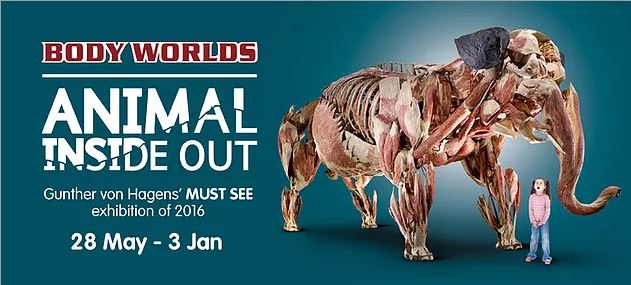By Grace Laws

Building upon the enormous success of the Bodyworlds exhibition, Dr Gunther von Hagens and Dr Angelina Whalley have brought to life the intricate features of animal physiology in their latest exhibition, Animal Inside Out. Aptly described as an “anatomical safari” with more than 100 plastinates on display, the exhibition enables an expedition of anatomy through the animal kingdom.
Plastinates in this exhibition have been created by the technique invented by Dr Gunther von Hagens. Plastination itself brings decomposition to a standstill, resulting in a completely sterile and durable specimen. The process begins by injecting formalin into the body, preserving it in the short-term and delaying the onset of rigor mortis. Dissections of the skin and connecting tissues allow for preparation of the anatomical structures. Next, liquids and soluble fats are immersed in a solvent bath. The solvent, e.g. acetone, replaces all of the liquids and fats that are otherwise problematic for preservation. To replace the acetone in the body, a second exchange is carried out by vacuum impregnation with a reactive polymer. Following this, the body is positioned for display and hardened with gas, light or heat to finish the process. The total process is lengthy, with the average time for one plastination equal to a full year of work.
Addressing the rather large African elephant within the room, those interested in viewing the exhibition can rest assured that no animals were killed for the purpose of this exhibition. Animals have been donated through University veterinary programmes, zoos and animal groups. Although the prospect of plastination may be gut wrenching to some, the educational value of exhibits has enabled the acceptance of plastination in today’s society. The aim of Animal Inside Out is to encourage admiration and understanding of nature’s wonders. Fascinating evolutionary deviations of anatomy and organ function are highlighted, such as the powerful 11kg giraffe heart that is required to pump blood up its 1.8m long neck to the brain. Organs from various species presented side by side allow an interactive comparison of physiology. The exhibition successfully and innovatively reveals the sophistication of anatomy to anyone interested. Animal Inside Out can be viewed in addition to on-going exhibitions at the renowned Centre for Life. A trip is definitely recommended. For more information on Animal Inside Out please visit: http://www.life.org.uk/whats-on/animal-inside-out For more information on Plastination please visit: http://isp.plastination.org/about.html
Animal Inside Out can be viewed in addition to on-going exhibitions at the renowned Centre for Life. A trip is definitely recommended. For more information on Animal Inside Out please visit: http://www.life.org.uk/whats-on/animal-inside-out For more information on Plastination please visit: http://isp.plastination.org/about.html